| Computers, Materials & Continua DOI:10.32604/cmc.2022.030157 |  |
| Article |
Impairments Approximations in Assembled mmWave and Radio Over Fiber Network
1Electrical Engineering Department, College of Engineering, Najran University, Najran, 61441, Saudi Arabia
2Department of Electrical Engineering, Qurtuba University of Science and IT, Dera Ismail Khan, 29050, Pakistan
3Department of Electrical Engineering, University of Engineering Technology, Mardan, 23200, Pakistan
4Department of Electrical Engineering, College of Engineering, Jouf University, Sakaka, Saudi Arabia
5Faulty of Electrical Engineering, University of Engineering and Technology, Peshawar, Pakistan
6Faculty of Maritime Studies, King Abdulaziz University, Jeddah, 21589, Saudi Arabia
7Department of Electrical Engineering, Sarhad University of Science and Information Technology, Peshawar, 25220, Khyber Pukhtunkhwa, Pakistan
8Ports & Maritime Transportation Faculty of Maritime Studies King Abdulaziz University, Jeddah, Saudi Arabia
9Nautical Science Department, Faculty of Maritime Studies, King Abdulaziz University, Jeddah, Saudi Arabia
*Corresponding Author: Fazal Muhammad. Email: fazal.muhammad@uetmardan.edu.pk
Received: 19 March 2022; Accepted: 29 May 2022
Abstract: The fiber nonlinearity and phase noise (PN) are the focused impairments in the optical communication system, induced by high-capacity transmission and high laser input power. The channels include high-capacity transmissions that cannot be achieved at the end side without aliasing because of fiber nonlinearity and PN impairments. Thus, addressing of these distortions is the basic objective for the 5G mobile network. In this paper, the fiber nonlinearity and PN are investigated using the assembled methodology of millimeter-wave and radio over fiber (mmWave-RoF). The analytical model is designed in terms of outage probability for the proposed mmWave-RoF system. The performance of mmWave-RoF against fiber nonlinearity and PN is studied for input power, output power and length using peak to average power ratio (PAPR) and bit error rate (BER) measuring parameters. The simulation outcomes present that the impacts of fiber nonlinearity and PN can be balanced for a huge capacity mmWave-RoF model applying input power carefully.
Keywords: Fiber nonlinearity; phase noise; radio over fiber network; advanced modulation system
High capacity data transmission is the key goal of 5G mobile network, which is possible by combined structure of optical and wireless communication systems [1]. This mechanism has resolved multi user and high definition (HD) data transmission issues over long distances. However, the enhancement of online services and video based data transmission have induced new impairments like fiber nonlinearity and phase noise (PN) [2]. These impairments have bounded the performance of existing communication setups. In struggle for new approaches, aiming to develop 5G mobile network flexibility, joint structure of millimeter wave and radio over fiber (mmWave-RoF) system is considered a promising solution [3,4]. Secondly, the cost effective and low complex framework like features have allocated the researches and various mechanisms are presented so far. For example in [5], the authors have proposed a solution for fiber dispersion and nonlinearities on quadrature amplitude modulation (QAM) signals of RoF system. The study in [6], compares different filters for optical microwave signals in RoF system and investigates the stimulated berrillion scattering. The power penalties by reason of nonlinear and dispersion losses were discussed in [7], applying split-step Fourier method. The performance limitations of RoF system by the influence of fiber nonlinearity are investigated in [8] based on analytical model. In [9], the authors have anlyzed a mixed free space optics (FSO) and RoF for enhancement system efficiency and addressing the impact of nonlinearities. Hadi. M.U [10] studied 64QAM-RoF system for 10 km range and nonlinearities are mitigated. The nonlinear impairments are suppressed in [11], for long range RoF system using 16, 32 and 64 QAM modulation schemes. Reference [12], explains teh low cost directly modulated laser for wavelength division multiplexing-RoF (WDM-RoF) system in order to enhance 5G mobile network performance. In [13], the authors have explored optical aided beam forming mechanism purposing to maintain RoF outcomes and balance the impacts of fiber nonlinearity optimally. RoF system is investigated in [14], using 128QAM and 40 Gbps signals, where the factors of nonlinearity are evaluated up to 70 km path covered using support vector machine (SVM) method. The paper [15], examines the feasibility of RoF system for 5G mobile network. The distortions induced by laser chirp are addressed successfully. The authors have suggested a RoF system for downlink and uplink modulations. The fiber nonlinearity impairments and PN are evaluated in this paper using the assembled methodology of mmWave-RoF. The model is investigated analytically using nonlinear parameters, PN and estimating parameters. The outage probability, peak to average power ratio (PAPR) and bit error rate (BER), fiber lengthand transmitted power are derived for huge capacity mmWave-RoF system. The impact of fiber nonlinearity and PN are quantified analytically for the first time in this paper.
In order to optimally balance the fiber nonlinearity and PN, the mmWave-RoF system is discussed in this paper. This research model includes the following major contributions.
1. Flexible 5G mobile network requires smooth communication setup, through which high capacity and HD based video are transformed accurately. Taking such point the mmWave-RoF is designed in terms of mathematical and outage probability investigations.
2. It is noted that long range, huge capacity transmission and intense laser input power generate fiber nonlinearity and PN, which are the key major factor of bounded RoF outcomes. These issues are minimized fruitfully using joint structure of mmWave and RoF including advance modulation frameworks.
3. The measuring parameters like bit error rate (BER), peak to average power ratio (PAPR) and optical signal to noise ratio (OSNR) are studied for evaluating system performance and impacts of fiber nonlinearity and PN.
4. The main elements like length of fiber, input and output powers, number of users are selected, aiming to detect the reason behind fiber nonlinearity and PN inductions.
5. The results are examined evolving 24 and 25 GHz RF range, 20 km fiber length, −38 to −18 dBm output power, and −8 to 0 dBm input power. That declares that the mmWave-RoF system with advanced modulation schemes has ability to optimize the factors of fiber nonlinearity and PN and enhance 5G mobile network functions.
This paper is organized as follows, Section 2 describes the proposed setup of mmWave-RoF system, the analytical approach is discussed in Section 3, the results and discussion are examined in Section 4, in conclusion the proposed mmWave-RoF system is summarized in Section 5.
In this paper simple model of RoF is employed for fronthaul as depicted in Fig. 1. The mmWaves are received from source ’
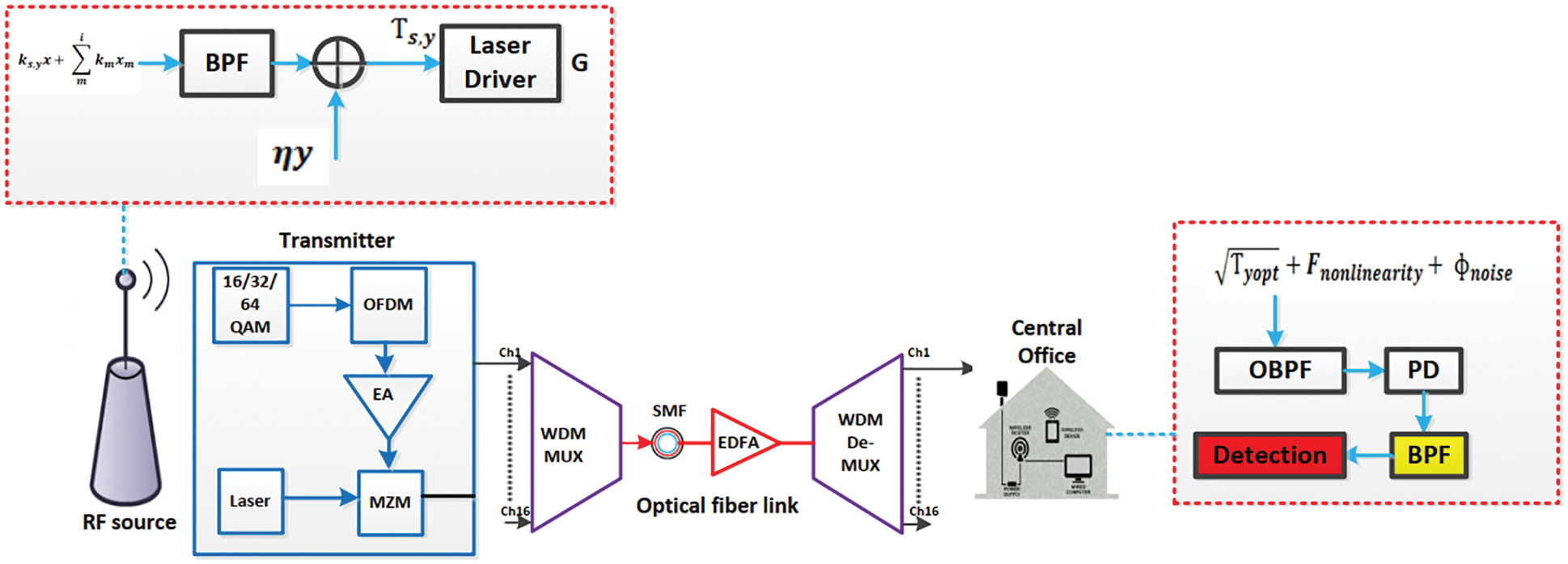
Figure 1: Presented structure of mmWave-RoF system
3 Analytical Investigations of mmWave-RoF Model
This section presents the theoretical analysis of mmWave-RoF suggested model. The attained signals from RF at transmitter end of the optical network are defines [16,17] as
where fading coefficient is denoted by
where
where
The parameter
The dissolved
where
Substituting Eqs. (8) and (9), the Eq. (10) can be discussed as
The estimating parameter BER for modulated binary data is given as
where
The asymptotic ‘

In this work the wireless communication connectivity is enhanced for 5G mobile networks, utilizing the mmWave-RoF system. The outage probability of proposed system is derived in aforementioned section. The simulation calculations are studied in this section, employing the derived analytical approach. Fig. 2 justifies the performance for simple RoF and proposed mmWave-RoF model. This explains that the mmWave-RoF outcomes are efficient than simple RoF link. At lower input power like −10 to −6 dBm the system gives maximum BER neat to threshold. Fig. 2 also presents the comparison among 24 and 25 GHz RF waves, which proves that the mmWave-RoF includes higher RF waves, adds nonlinear signals to the original waves. The proposed mmWave-RoF model results using length of fiber and BER estimating entities are discussed in Fig. 3. The correlations between simple RoF system in terms of −2 and −4 dBm are investigated. Normally, with maximum fiber range the optical system induces worst outcomes on the account of fiber nonlinearity and PN. However, Fig. 3 shows that the mmWave-RoF system has maintained its performance at long distance and gives BER below threshold. On the other side the simple RoF system with −4 dBm laser power, contains major nonlinear issues. Received power as a function of BER estimations are viewed in Fig. 4 for 10 and 5 km path covered. The results are evaluated for both balanced fiber nonlinearity and PN and included fiber nonlinearity and PN. It is noted from simulation study that more power is consumed by reason of fiber nonlinearity based mmWave-RoF model. At 10 km path span, −2 dBm power penalty is recorded with 10−4 BER, which above the threshold. Therefore, the investigations of fiber nonlinearity and PN are important in practical system, which are installed for huge capacity and long range transmission. Suggested mmWave-RoF system is tested for number of users which is the key parameter for 5G flexible network. This discussion is disclosed in Fig. 5, including 262144 samples and 100 guard bits.
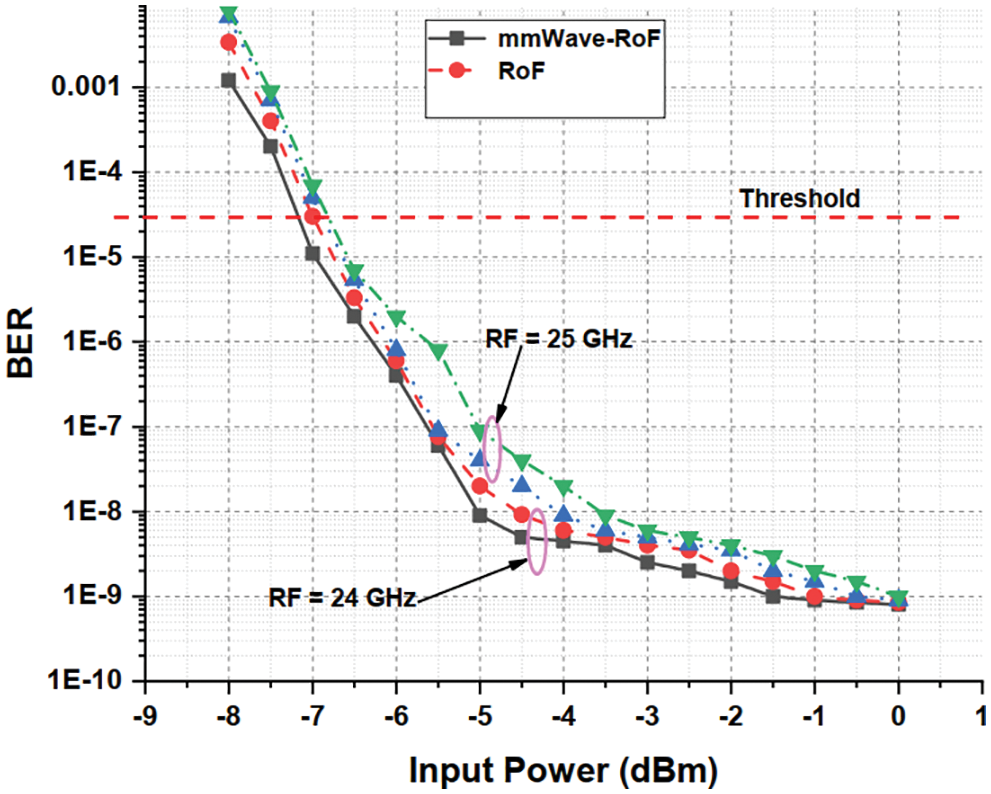
Figure 2: Experimental analysis of mmWave-RoF proposed model using input power and BER for 24 and 25 GHz RF waves
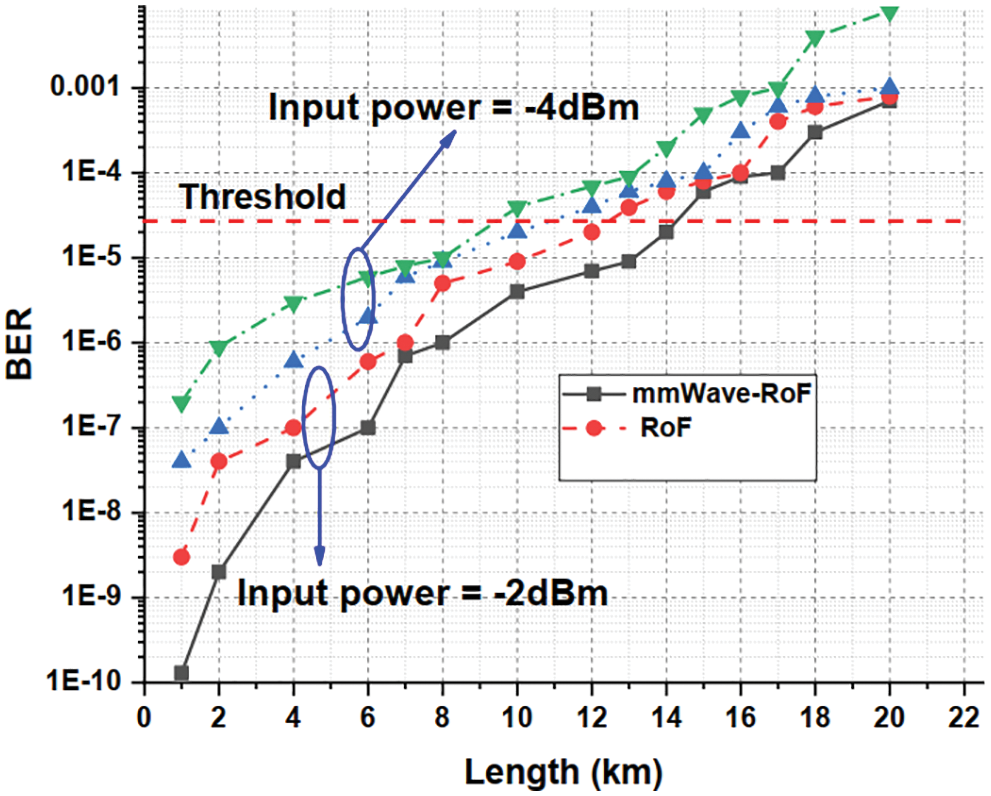
Figure 3: Comparison of existing RoF system and proposed mmWave-RoF system in terms of Length against BER
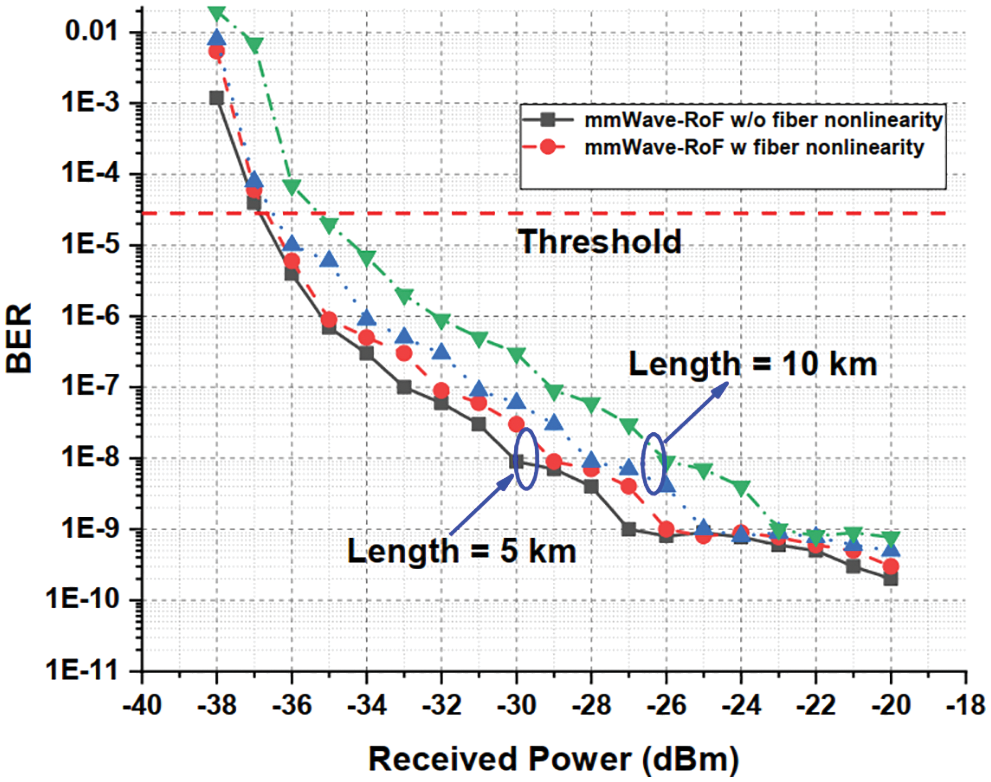
Figure 4: Experimental discussion of received power vs. BER for investigating fiber nonlinearity
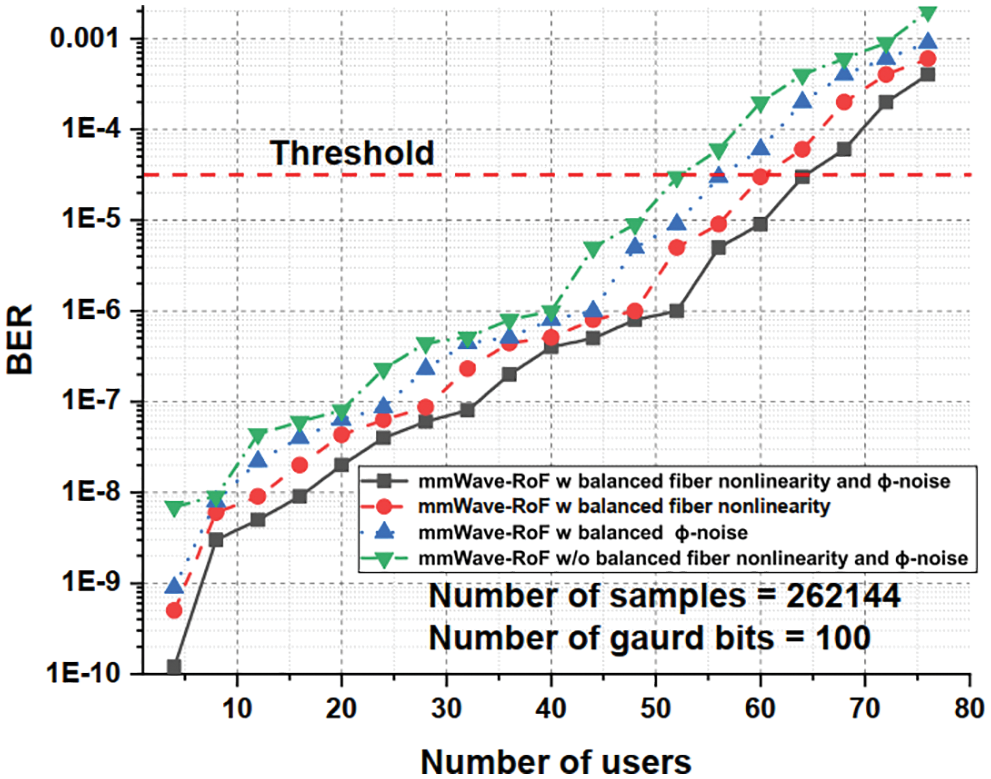
Figure 5: Number of users as a function of BER simulation estimations for ϕ-noise and fiber nonlinearity
In addition, Fig. 5 consists of fiber nonlinearity, PN and simple RoF model calculations, that express the badly corrupted data as a result of nonlinear impairments. These impairments become more prominent with maximum number of users. For example the mmWave-RoF system having users more than 50 gives limited BER. The same model with optimally balanced fiber nonlinearity and PN provides accurate information at the detector of the receiver side.
The higher data rate speed such as 100 and 112 Gbps are applied at the proposed model and the estimations are judged among balanced fiber nonlinearities and PN mmWave-RoF system and unbalanced fiber nonlinearity and PN mmWave-RoF system. These measurements are included in Fig. 6 based on laser power and OSNR at 20 km transmission range. The analysis gives that the system with existing of fiber nonlinearity and PN signals provide worst results as mentioned in Fig. 6. Secondly, the OSNR of the system is improved after cleaning the pulses from the noises (fiber nonlinearity and PN). The back to back, nonlinear and PN consumed channels and cleans outputs waves, performance of the proposed mmWave-RoF system are evaluated using constellation and RF spectrum measurements. These calculations are provided in Figs. 7a and 7c at 112 Gbps data rate and 20 km covered path. The Figs. 7a–7c define that the proposed model has efficiently resolved the impairments of nonlinearity and PN for huge capacity transmission. Similarly, the comparison of Figs. 8a–8c depict that the high data rate signals are badly expanded due to fiber nonlinearity and PN. Thus, it shows a clear mechanism is always need to overlook the high order distortions for 5G networks as mentioned in Fig. 8c. In summary the Simulation study explains that the clear difference between balanced mmWave-RoF signals and fiber nonlinearity and PN added channels.

Figure 6: Laser power investigations against OSNR using 100 and 112 Gbps data rates

Figure 7: Constellation analysis of the proposed mmWave-RoF system; (a) back to back mmWave-RoF system performance, (b) fiber nonlinearity and PN included mmWave-RoF system performance, (c) optimally fiber nonlinearity and PN balanced mmWave-RoF system performance at 20 km transmission range and 112 Gbps data rate speed
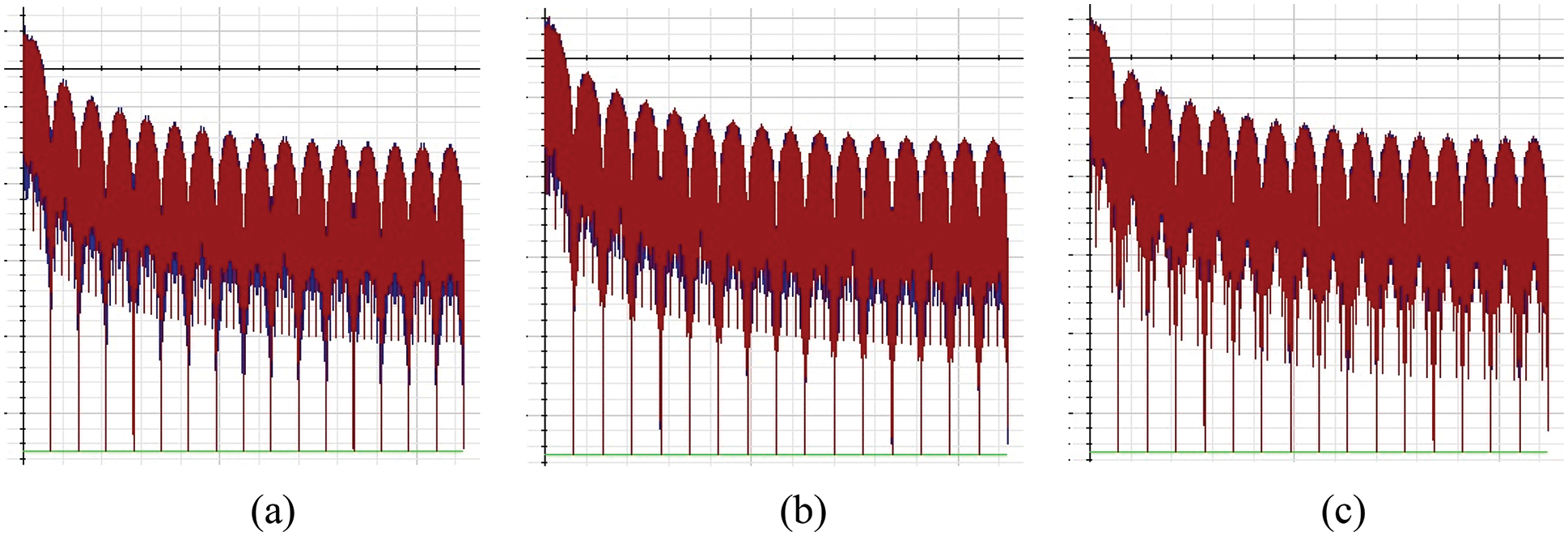
Figure 8: Signals spectrum investigations; (a) Back to back signal spectrum performance, (b) The mmWave-RoF signals spectrum with fiber nonlinearity and PN, (c) Outcomes performance of mmWave-RoF system after optimally balanced the impact of fiber nonlinearity and PN at 20 km transmission range and 112 Gbps data rate speed
Tab. 2 explains the comparison of proposed architecture with existing models.

In the existence of fiber nonlinearity and PN distortion mmWave-RoF system is discussed in this paper. The detail analytical model in terms of outage probability, performance and measuring elements are derived. The investigations show that for 5G networks need purified and flexibility based models, which can only be possible by managing the high order nonlinear impairments and PN. Looking to these required demands, simple and low-cost strategy is proposed in order to optimally balance the fiber nonlinearity and PN. The simulation estimations are analyzed using length of fiber, number of users, OSNR, BER and input/output powers. The results investigation concludes that the presented mmWave-RoF system efficiently develop the performance of transmitted channels at huge capacity and long-distance data transmissions. In future the mmWave-RoF exhibitions can be further improved, employing advance machine learning and artificial techniques.
Acknowledgement: The authors acknowledge the support from the Deanship of Scientific Research, Najran University. Kingdom of Saudi Arabia, for funding this work under the research groups funding program Grant Code Number (NU/RG/SERC/11/3).
Funding Statement: The authors acknowledge the support from the Deanship of Scientific Research, Najran University. Kingdom of Saudi Arabia, for funding this work under the research groups funding program grant code number (NU/RG/SERC/11/3).
Conflicts of Interest: The authors declare that they have no conflicts of interest to report regarding the present study.
References
1. C. Dehos, J. L. González, A. De Domenico, D. Kténas and L. Dussopt, “Millimeter-wave access and backhauling: The solution to the exponential data traffic increase in 5G mobile communications systems,” IEEE Communication Magazines, vol. 52, no. 9, pp. 88–95, 2014. [Google Scholar]
2. A. E. Morra, K. Ahmed and S. Hranilovic, “Impact of fiber nonlinearity on 5G backhauling via mixed FSO/fiber network,” IEEE Access, vol. 5, no. 1, pp. 19942–19950, 2017. [Google Scholar]
3. M. U. Hadi, “Mitigation of nonlinearities in analog radio over fiber links using machine learning approach,” ICT Express, vol. 7, no. 2, pp. 253–258, 2021. [Google Scholar]
4. B. G. Kim, S. H. Bae, H. Kim and Y. C. Chung, “Feasibility of RoF-based optical fronthaul network for next-generation mobile communications,” in Opto-Electronics and Communications Conf. (OECC) and Photonics Global Conf. (PGC), Singapore, pp. 1–2, 2017. [Google Scholar]
5. E. Nahal and I. Fady, “A WDM-PON with DPSK modulated downstream and OOK modulated upstream signals based on symmetric 10 Gbit/s wavelength reused bidirectional reflective SOA,” Optoelectronics Letter, vol. 13, no. 1, pp. 67–69, 2017. [Google Scholar]
6. J. C. Cartledge, F. P. Guiomar, F. R. Kschischang, G. Liga and M. P. Yankov, “Digital signal processing for fiber nonlinearities,” Optical Express, vol. 25, no. 3, pp. 1916–1936, 2017. [Google Scholar]
7. G. Pandey, A. Choudhary and A. Dixit, “Wavelength division multiplexed radio over fiber links for 5G fronthaul networks,” IEEE Journal on Selected Areas in Communications, vol. 39, no. 9, pp. 2789–2803, 2021. [Google Scholar]
8. Y. Li, S. Ghafoor, K. Satyanarayana, M. El-Hajjar and L. Hanzo, “Analogue wireless beamforming exploiting the fiber-nonlinearity of radio over fiber-based C-RANs,” IEEE Transactions on Vehicular Technology, vol. 68, no. 3, pp. 2802–2813, 2019. [Google Scholar]
9. M. U. Hadi, A. Basit and K. Khurshid, “Nonlinearities mitigation in radio over fiber links for beyond 5G C-RAN applications using support vector machine approach,” in IEEE 23rd Int. Multitopic Conf., Bahwalpur, Pakistan, pp. 1–5, 2020. [Google Scholar]
10. M. K. A. Khan, F. Ali, M. Irfan, F. Muhammad, F. Althobiani et al., “Mitigation of phase noise and nonlinearities for high capacity radio-over-fiber Links,” Electronics, vol. 10, no. 3, pp. 345–355, 2021. [Google Scholar]
11. B. Wang, L. Peng and P. Ho, “Energy-efficient radio-over-fiber system for next-generation cloud radio access networks,” Journal of Wireless Commmunication Network, vol. 118, no. 1, pp. 1–8, 2019. [Google Scholar]
12. N. Kathpal and A. K. Garg, “Analysis of radio over fiber system for mitigating four-wave mixing effect,” Digital Communications and Networks, vol. 6, no. 1, pp. 115–122, 2020. [Google Scholar]
13. G. Li, Z. Lin, X. Huang and J. Li, “A radio over fiber system with simultaneous wireless multi-mode operation based on a multi-wavelength optical comb and pulse-shaped 4QAM-OFDM,” Electronics, vol. 8, no. 10, pp. 1064–1075, 2019. [Google Scholar]
14. J. L. Li, F. Zhao and J. Yu, “D-band millimeter wave generation and transmission though radio-over-fiber system,” IEEE Photonics Journal, vol. 12, no. 2, pp. 1–8, 2020. [Google Scholar]
15. W. Li, A. Chen, T. Li, R. V. Penty, I. H. White et al., “Novel digital radio over fiber (DRoF) system with data compression for neutral-host fronthaul applications,” IEEE Access, vol. 8, no. 1, pp. 40680–40691, 2020. [Google Scholar]
16. V. Sharma, S. Sergeyev and J. Kaur, “Adaptive 2 × 2 MIMO employed wavelet-OFDM-radio over fibre transmission,” IEEE Access, vol. 8, no. 1, pp. 23336–23345, 2020. [Google Scholar]
17. J. Kim, H. Lee, S. Park and I. Lee, “Minimum rate maximization for wireless powered cloud radio access networks,” IEEE Transactions on Vehicular Technology, vol. 68, no. 1, pp. 1045–1049, 2019. [Google Scholar]
18. Z. Tang, J. Zhang, S. Pan, G. Roelkens and D. Van Thourhout, “Ring-modulator-based RoF system with local SSB modulation and remote carrier reuse,” Electronics Letters, vol. 55, no. 20, pp. 1101–1104, 2019. [Google Scholar]
19. F. Ali, U. Habib, F. Muhammad, Y. Khan, A. Armghan et al., “Alleviation of nonlinear channel effects in long-haul and high-capacity optical transmission networks,” International Journal of Communication Systems, vol. 35, no. 4, pp. 1–16, 2022. [Google Scholar]
20. H. Zhang, H. G. Batshon, C. R. Davidson, D. G. Foursa and A. Pilipetskii, “Multi dimensional coded modulation in long-haul fiber optic transmission,” Journal of Lightwave Technology, vol. 33, no. 13, pp. 2876–2883, 2015. [Google Scholar]
21. N. Stojanovic and X. Changsong, “An efficient method for skew estimation and compensation in coherent receivers,” IEEE Photonics Technology Letters, vol. 28, no. 4, pp. 489–492, 2016. [Google Scholar]
22. K. Benyahya, C. Simonneau, A. Ghazisaeidi, N. Barr, P. Jian et al., “Multiterabit transmission over OM2 multimode fiber with wavelength and mode group multiplexing and direct detection,” Journal of Lightwave Technology, vol. 36, no. 2, pp. 355–360, 2018. [Google Scholar]
23. Q. Zhuge and X. Chen, “Advances in modulation and DSP for optical transmission systems,” Journal of Optics Communication, vol. 409, no. 1, pp. 1–13, 2018. [Google Scholar]
24. D. Maharana and R. Rout, “A 4 channel WDM based hybrid optical Fiber/FSO communication system using 207 DP QPSK modulation for bit rate of 100/112 Gb/s,” International Journal of Engineering Research and Technology, vol. 8, no. 6, pp. 442–445, 2019. [Google Scholar]
25. F. Ali, F. Muhammad, U. Habib, Y. Khan and M. Usman, “Modeling and minimization of FWM effects in DWDM-based long-haul optical communication systems,” Photonic Network Communications, vol. 41, no. 1, pp. 36–46, 2021. [Google Scholar]
26. A. E. Morra and S. Hranilovic, “Mixed mmWave and radio-over-fiber systems with fiber nonlinearity,” IEEE Photonics Technology Letters, vol. 31, no. 1, pp. 23–26, 2019. [Google Scholar]
 | This work is licensed under a Creative Commons Attribution 4.0 International License, which permits unrestricted use, distribution, and reproduction in any medium, provided the original work is properly cited. |